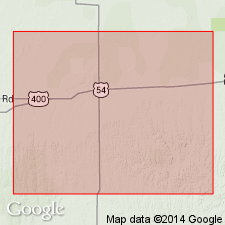
- Usage in publication:
-
- Black Hill shale
- Modifications:
-
- Original reference
- Dominant lithology:
-
- Shale
- AAPG geologic province:
-
- Anadarko basin
Summary:
Pg. 90. Black Hill shale. Unique deposit of carbonaceous and rapidly decomposing shale, which affords an easily recognized horizon for reference in any studies that may be made of neighboring formations. Assigned to Benton.
Named from a locality a few mi southwest of Sun City, locally known as Black Hill, Comanche Co., central southern KS [see also F.W. Cragin, 1890, Washburn College Lab. Nat. Hist. Bull., v. 2, no. 11, p. 71-72 footnote].
Source: US geologic names lexicon (USGS Bull. 896, p. 202).

- Usage in publication:
-
- Black Hill shale
- Modifications:
-
- Revised
- AAPG geologic province:
-
- Anadarko basin
Cragin, F.W., 1895, A study of the Belvidere beds: American Geologist, v. 16, p. 357-385.
Summary:
Pg. 379. Black Hill shale. Black carbonaceous clay shale, 15 or 20 feet thick, forming basal bed of Fullington shales. Overlain by Blue Cut shales (upper bed of Fullington shales) and underlain by Champion shell bed. Is also called Water shale. Assigned to Comanche Cretaceous.
Source: US geologic names lexicon (USGS Bull. 896, p. 202).
For more information, please contact Nancy Stamm, Geologic Names Committee Secretary.
Asterisk (*) indicates published by U.S. Geological Survey authors.
"No current usage" (†) implies that a name has been abandoned or has fallen into disuse. Former usage and, if known, replacement name given in parentheses ( ).
Slash (/) indicates name conflicts with nomenclatural guidelines (CSN, 1933; ACSN, 1961, 1970; NACSN, 1983, 2005, 2021). May be explained within brackets ([ ]).

